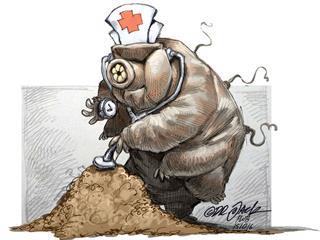
Photo: Dr Jack
Global economic growth over the past half-century has changed our world unrecognisably, driving exponential improvements in health, knowledge and standards of living.
Yet this has come at a huge cost to nature and the stability of Earth’s operating systems that sustain us.
Since 1970, global GDP has increased four times, the extraction of living materials from nature has tripled and the world’s human population has doubled, along with an enormous trend towards urbanisation. People living in cities now account for 50% of the global population.
Trade has exploded; the value of exports rose 200-fold from 1970 to 2017, with the largest increases in developed countries.
This boom has enabled higher-income countries to increase their consumption even though nature, within their own boundaries, is relatively well protected; much of the added consumption is from nature’s contributions imported from lower-income countries, and these contributions are sometimes surrendered for little economic growth.
The cost of the growth
The biodiversity cost of the world’s expanding population and economic output has been significant.
Since the industrial revolution, human activities have increasingly destroyed and degraded forests, grasslands, wetlands and other important ecosystems, threatening human well-being. Seventy-five percent of Earth’s ice-free land surface has already been altered significantly, most of the oceans are polluted, and more than 85% of the area of wetlands has been lost.
This destruction of ecosystems has led to one million species (500 000 animals and plants and 500 000 insects) being threatened with extinction.
Since 1970, our ecological footprint has exceeded the rate at which the world’s ecosystems can regenerate. This overshoot erodes the planet’s health and, with it, humanity’s prospects. Human enterprise currently demands 1,56 times more than the amount that the Earth can regenerate. It is like living off 1,56 Earths.
The Living Planet Index (LPI), used since 1970 to calculate the average percentage change in population sizes for mammals, birds, fish, reptiles and amphibians, now tracks about 21 000 populations of animals by employing wildlife population datasets gathered from almost 4 000 sources.
The percentage expressed by the LPI does not represent the number of individual animals lost, but the average proportional change in animal population sizes tracked over 46 years. Using the data from 20 811 populations of 4 392 species, the 2020 global LPI shows an average 68% decline in monitored populations between 1970 and 2016.
The most important direct driver of biodiversity loss in terrestrial systems over the past several decades has been land-use change, primarily the conversion of pristine native habitats (forests, grasslands and mangroves) into agricultural systems, while much of the oceans has been overfished.
The challenge is to transform agricultural and fishing practices, many of which are unsustainable today, into ones that produce the affordable and nourishing food we need while ensuring biodiversity.
For agriculture, this means using sustainable agro-ecological practices, reducing the use of chemicals, fertilisers and pesticides, and protecting soils and pollinators.
Soil biodiversity
Soil is a critical component of the natural environment, yet most people are totally unaware of, or underestimate, the vital role that soil biodiversity plays in the ecosystem services on which we depend.
Soil hosts one of the largest reservoirs of biodiversity on Earth: up to 90% of living organisms in terrestrial ecosystems, including some pollinators, spend part of their life cycle in soil habitats.
The variety of soil components, filled with air and water, creates an incredible diversity of habitats for a myriad different soil organisms that underpin our life on the planet.
Besides food production, soil biodiversity provides a vast range of ecosystem functions and services, including soil formation, the retention and purification of water, nutrient cycling, the degradation of some soil contaminants and the regulation of greenhouse gases, as well as sustaining plant, animal and human health. Without soil biodiversity, terrestrial ecosystems could collapse.
Recent research has shown that the loss of soil biodiversity is considered to be one of the major soil threats in many regions of the world. Future agricultural systems may need to combine traditional practices, nature-based solutions, and novel technologies such as artificial intelligence, DNA sequencing and microbiome-based precision farming in an effort to conserve and restore degraded soils.
The true cost of food
We cannot feed the world without agriculture, yet where and how we produce food is one of the biggest human-caused threats to biodiversity. This makes the transformation of our global food system more important than ever.
Obvious as it may seem, feeding a growing and increasingly affluent global population is the primary goal of our food system, and we cannot feed the world without agriculture.
Yet agriculture is the primary force behind the transgression of the so-called planetary boundaries for nitrogen, phosphorus, climate change, biosphere integrity, land-system change and freshwater use.
At the same time, the potential of agricultural systems to provide habitats, and vegetation corridors for species to move between these habitats, enhancing rather than eroding ecosystem services and landscape resilience, is increasingly being recognised.
Some agricultural systems and specific components within them, from riparian corridors, hedges, woodland patches and clearings in forests, to waterways, ponds or other biodiversity-friendly features of the production environment, can provide habitat for specific species.
On a landscape scale, crop and livestock farming can add diversity to the ‘mosaic’ of habitat types present, and such diversified agricultural landscapes can support much more biodiversity than was initially thought.
Agricultural systems can also be managed in such a way that they facilitate, rather than constrain, species dispersal through corridors and along migratory routes, which is especially important considering climate change.
Biodiversity is also of crucial importance for food production itself. It has been amply documented that biodiversity underpins ecosystem functions that help determine food production and security.
A high degree of diversity among species, varieties, breeds, populations and ecosystems can help maintain healthy soils, pollinate plants, purify water, protect against extreme weather events, or provide any of a range of other vital services.
Avoiding waste
Reducing food loss and waste also represents a critical opportunity to relieve environmental pressure on our planet.
An estimated one-third of the food produced for humans is lost or wasted; this amounts to about 1,3 billion tons every year.
In a multiplier effect, when food loss and waste occur along the supply chain, all the land, water, energy, seed, fertiliser, labour, capital and other resources that went into its production also go to waste.
Looking ahead to 2050, global land-use model projections show that, without changes in diet, food production and food loss and waste, agricultural areas will have to expand in order to meet increased food demand.
Projections indicate that, by 2050, cropland areas may have to be 10% to 25% larger than in 2005. Associated biodiversity losses may have negative effects on the delivery of ecosystem services, such as pollination and pest control, a situation compounded by the changing climate.
This makes reconciling global food production with biodiversity conservation one of the major challenges of the 21st century. –
The views expressed in our weekly opinion piece do not necessarily reflect those of Farmer’s Weekly.
This article is an excerpt from the WWF Living Planet Report 2020. To read the full report, visit livingplanet.panda.org.











